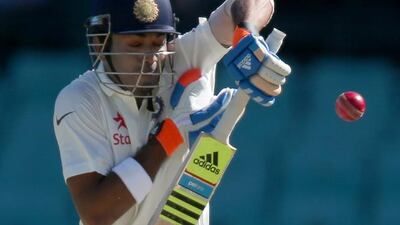As debuts go, it did not look as drastically bad as a pair of ducks. But KL Rahul’s first Test one Boxing Day at Melbourne last year, was as traumatic –14 balls across two innings, four runs (dropped once) and two messy, unforgettable dismissals.
He spoke about that introduction recently in an interview, a conversation that reveals something of modern batting.
In the first innings, Rahul was dismissed slog-sweeping a delivery well outside off stump. It was only the eighth delivery he had faced in Test cricket. Worse, the previous ball he had attempted an uglier slog, only to be dropped.
It was not, as he said, an attempt to feel like he belonged at this level. It was just the way batting is at all levels.
“I wanted to get that first boundary and feel good. Even when you are playing a first-class game, it is so important to get that first boundary,” he said.
In the second innings, again he was in search of that boundary.
Mitchell Johnson pulled midwicket in, bowled short and presto. Rahul saw a chance for an early boundary – his fifth ball – pulled but could only top-edge it high to be caught behind slips.
He is a better batsman than those dismissals suggest. In his next innings, at Sydney, he waited and waited, did not hit a boundary until his 35th ball and made 110.
It is worth wondering about his experiences and whether the modern and often reductive notion of attacking batting scrambles the minds of good, young batsmen.
Note the talk around this new Indian side into which Rahul has come, now under Virat Kohli. They want to play attacking cricket. They are going to be aggressive.
In an interview a couple of months ago, Kohli used the word “aggressive” or variants when talking about how he wants his team to play nine times. India’s loss to Sri Lanka last week in the first Test at Galle was blamed on an absence of attacking and aggressive batting.
Ahead of the next Test that starts tomorrow at Colombo, team director Ravi Shastri has adopted the pose of a battalion commander and insisted India will continue to attack.
Two things are worth noting.
One, we can only assume that, privately at least, the nuances of attacking batting are not lost. To be fair to Shastri, he did say publicly that just going “hell for leather” was not the only way to attack – looking for singles and rotating the strike could also be attacking.
But is that nuance trickling down? Sometimes it feels like it is not.
Rahul is not the only batsman who sees an early boundary as a comfort blanket, even if he has to go to some lengths to manufacture it. It is no surprise that he was batting with Kohli during that first innings.
Kohli had encouraged him to take on Nathan Lyon, if he felt he could. “Don’t shy away or think too much,” was the advice. It is the modern batting creed.
The other is that this kind of binary language simplifies the game. Cricket does not exist simply between the states of attack and defend. Cricket is nothing if not an excessively elaborate game, each result a vast and heaving mesh of tactics, strategy, instinct, talent, formula, spontaneity and, above all, tempo.
It is tempo that is most often mistaken to be just attacking or defending. Nothing could be further from reality.
Take, as just one example, the tempo of any big Younis Khan innings and his most recent in Sri Lanka. They cannot be said to be attacking, per se, or defensive. Instead, it is usually as Test batting should be: not a switch between two settings, but a spectrum across which batsmen glide, moving to adjust to situations and mini-situations.
Reducing batting in this way is self-defeating. In India’s case, talk of attack has clouded over tangible glitches in skill against spin, especially in defending deliveries. Over in England, meanwhile, Australian collapses have been framed in similar terms, of an inclination to attack and reluctance to defend.
There is something to that, too, but it has overshadowed a deeper failure in skill and technique that too many Australian batsmen have shown around the world.
osamiuddin@thenational.ae
Follow us on twitter at @NatSportUAE

